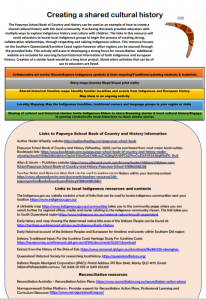7 Creating a shared cultural history
Deirdre Byrne
Rationale
The Papunya School Book of Country and History is a unique book that shares the history of the formation of the Papunya community. This book can be used as an inspiration to early childhood centres and schools to promote reconciliation through a creation of a similar shared cultural history. When used as a holistic learning experience, the collection of activities and shared histories can transform the thinking of educators, students and families about Indigenous and western cultures (de Vere & Wheatley, n.d.). There are also opportunities for modifiable, standalone projects within this activity that are listed in the resource.
This activity fosters strong relationships with the local Indigenous community founded on respect for, valuing of and understanding of culture, and ways of knowing and being (Queensland Curriculum & Assessment Authority, 2018a). Through inviting Elders into the learning space via the creative process, educators are able to embed indigenous culture into the learning environment and in turn, develop stronger relationships with all families and community members (Department of Education [DET], 2011). When accessing Indigenous materials, it is essential that this is done in a culturally respectful way and that cultural protocols are adhered to (DET, 2011). The activities listed assist educators and families to share the responsibility for understanding culture through embracing a shared legacy (Atkinson, 2016) and to assist in the reconciliation process (Reconciliation Australia, 2019a). Culture is central to our sense of identity and plays a part in the feelings of “being” and ‘becoming’ that is a cornerstone of the Early Years Learning Framework. By creating a visible, shared cultural history, we create a welcoming learning environment and positive sense of identity for all families, children and staff (DEEWR, 2009).
Links to the ELYF
Outcome 1. Children have a strong sense of identity; Children develop knowledgeable and confident self-identities
Outcome 2. Children are connected with and contribute to their world; Children develop a sense of belonging to groups and communities, Children respond to diversity with respect
Outcome 3. Children have a strong sense of wellbeing; Children become strong in their social and emotional wellbeing
Outcome 4. Children are confident and involved learners; Children resource their own learning through connecting with people, place, technologies and natural and processed materials
Outcome 5. Children are effective communicators. Children interact verbally and non-verbally with others for a range of purposes, Children engage with a range of texts and gain meaning from these texts
National Quality Standards
Standard 6.1 Supportive relationships with families: Respectful relationships with families are developed and maintained and families are supported in their parenting role.
Element 6.1.2 Parent views are respected – The expertise, culture, values and beliefs of families are respected, and families share in decision-making about their child’s learning and wellbeing.
Standard 6.2 Collaborative partnerships – Collaborative partnerships enhance children’s inclusion, learning and wellbeing.


